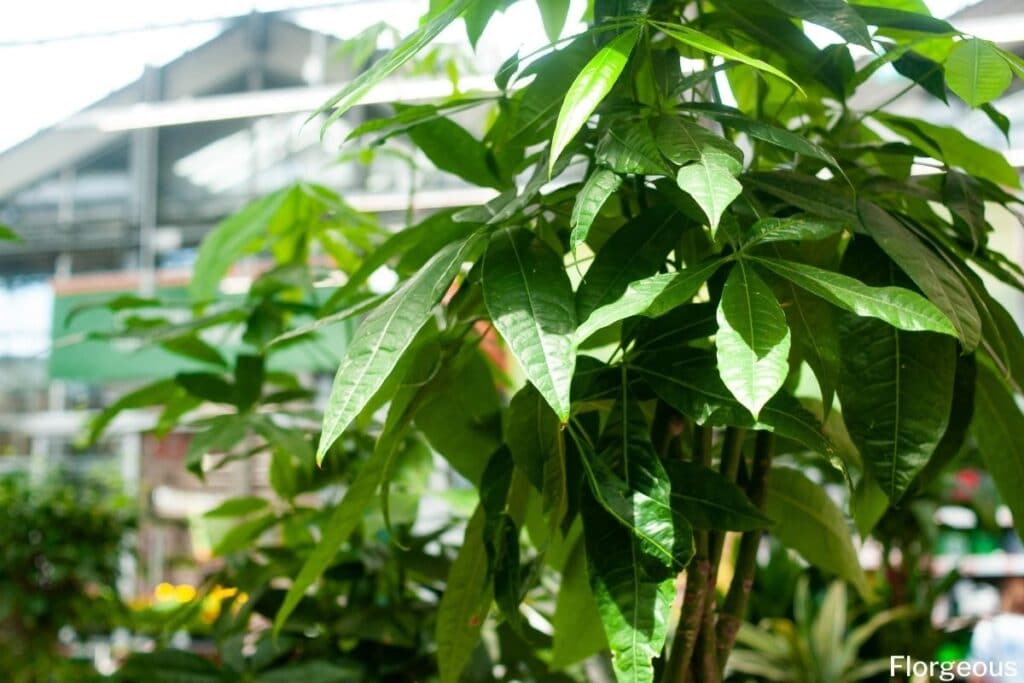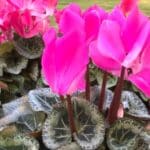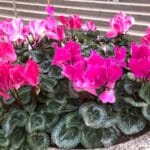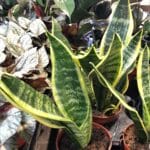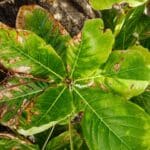The money tree (Pachira sp.) is a very popular and beautiful houseplant. These Central and South America trees are typically sold as 3-7 braided stems and are said to bring good luck and fortune to whoever grows them. Read on to learn how to grow and care for these amazing indoor plants.
There are in fact two species of Pachira that are popular in cultivation. They are easily confused, and many of the plants sold as Pachira aquatica are in fact P. gabra. The two different species are most easily separated by the color of the bark and the flowers. P. aquatica has brown-grey bark and some red on the flowers, while in P. gabra, the bark is greenish and the flowers are all white.
These tropical evergreen trees can grow to 60 feet (18m) in their natural habitat and produce tasty and edible nuts. In spite of their large size, they are easily pruned and make fantastic houseplants. The glossy-green compound leaves have 5 or more leaflets, lending these plants an attractive and unique look.
Legend has it that the Pachira money trees brought good fortune to a struggling man after he found it and began to grow it. Regardless of whether the folklore holds any truth or not, this plant certainly deserves a space in any houseplant collection.
Plant Facts
| Scientific name | Pachira aquatica, P. glabra |
| Common names | Money tree, Malabar chestnut, Guiana chestnut, provision tree, saba nut, French peanut, pachira nut |
| Family | Malvaceae |
| Plant Type | Evergreen tree, tropical tree, houseplant |
| Height and Width | 4-8 ft. tall (indoors), 1–3 ft. wide (indoors) |
| Origin | Southern Mexico, Northern Brazil, Bolivia |
| Flower colors | White, white and red |
| Foliage color | Glossy green |
| Sun Exposure | Bright indirect light |
| Soil Type & pH | Well-drained, neutral pH soil |
| Special features | Good luck plant |
How to Grow the Pachira Aquatica Money Tree
These lucky plants are most popularly grown as houseplants. The money tree bonsai also makes one of many popular bonsai specimens, and can even be grown outdoors as a tropical tree for zones 10-12. Read on for more indoor growing tips.
Propagation
A Pachira houseplant can be grown from seed or cuttings. Seeds are not easily obtainable from houseplants, however, because this plant with a braided trunk rarely flowers indoors.
Rooting stem tip cuttings is a reliable propagation technique because they strike well with or without the use of a root hormone powder. A 6 inch (15cm) cutting with several nodes may root in 6 to 8 weeks. The cuttings can be set in water or moist, warm soil.
Soil
Well-drained indoor potting mix is the ideal choice for the money tree houseplants. Soil with a neutral pH is recommended. These money tree plants are able to withstand saturated soil for short periods of time but will benefit from a well-drained medium.
Pruning
This money plant responds very well to pruning, which will be a necessity when the plant grows too large or if you wish to neaten or shape the plant. Both the foliage and the roots can be trimmed once the plant reaches the largest size you are comfortable with.
Fall is a great time to prune this plant. Always use a sharp, sterilized cutting tool and remember to remove whole leaves, rather than just the leaflets. Remove any dead leaves or yellow or brown leaves from the plant, taking care to remove all plant material from the soil surface.
You can continue to braid the stems of the plant as they grow taller. Do this before the new leaf growth hardens off and remember to secure the tops of the stems with a tie to keep them in place.
Repotting and Transplanting
This Guiana Chestnut tree grows fairly fast under good conditions and will eventually need to be up-potted to a larger container. Be sure to water the plant well before being transplanted to reduce stress and to keep the soil consolidated around the root mass.
Choose a pot 1 or 2 sizes larger than the original. Drainage is very important, so select a container with holes in the bottom, or you may need to drill your own. When you feel the plant has grown to the size you want, do not move it to a larger pot, but trim the roots and return it to the same pot instead.
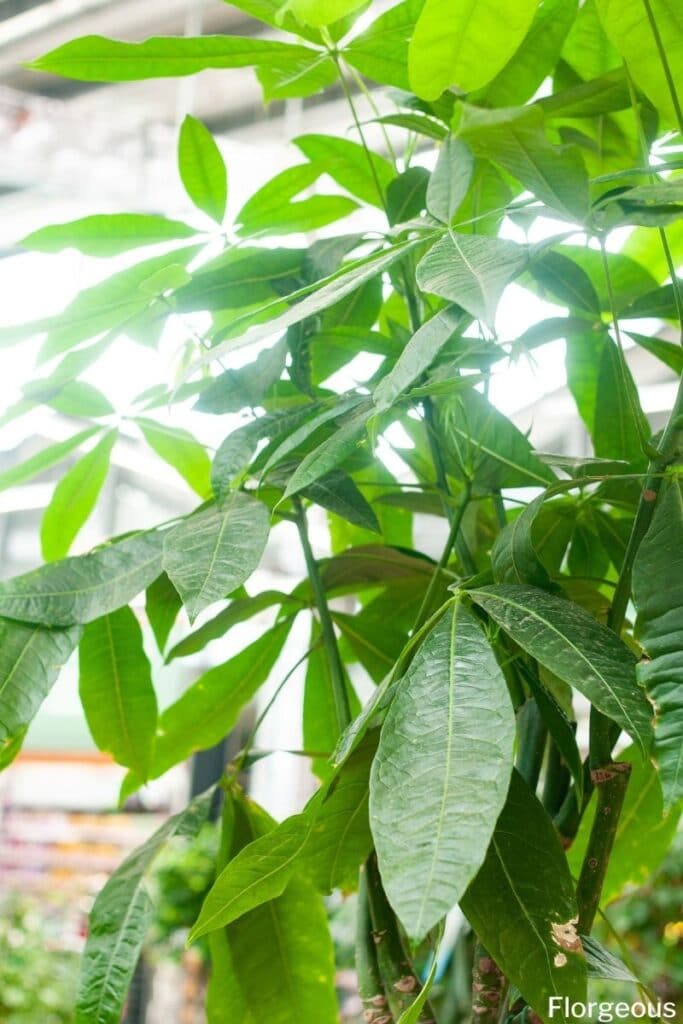
How to Care for a Pachira Money Tree Houseplant
The Pachira plant is relatively forgiving and easy to care for as an indoor plant. Keeping the soil moist and providing the plant with access to sufficient bright but indirect light are important keys to success. Read on for more important money tree care tips.
Water
The Pachira money tree prefers constant access to water, but should not be grown in saturated soil. Water the plant once every week or two when the soil has dried out to a depth of an inch or 2 (2.5-5cm).
Soak the soil until you see water draining from the drainage holes at the bottom of the container, this way you will know that the soil has been watered through. You can keep this plant fairly dry in the winter non actively growing period to mimic the natural dry season.
Sunlight
These plants should not be grown in direct sunlight but will still need enough light to thrive. Bright indirect light or dappled light near an east or west-facing sunny window is ideal. Rotate the plant monthly to keep it straight and even.
Temperature and Humidity
Pachira trees are adapted for life in warm, moist tropical environments. Both species prefer higher humidity. There are a number of ways in which you can create a humid growing environment for your plants. These include:
- Growing the Pachira tree in a naturally humid space like the kitchen or bathroom
- Positioning several moisture-loving plants together in close proximity
- Placing the plant’s pot on a shallow container filled with water and pebbles
- Using a purpose-built electric humidifier
These plants are adaptable to a wide range of temperatures and do very well in standard household room-temperatures. They are not frost-hardy, however, so do not grow them outdoors in cold climates. This plant should also be kept away from cold draughts near open windows.
Fertilizer
Fertilize the pachira tree in the spring and summer growing season. Reduce or stop fertilizing in the fall and winter. Use a balanced, all-purpose fertilizer at half strength to improve the health and vigor of your plant.
Pest and diseases
The Pachira money tree plant is generally pest resistant but keep an eye out for common houseplant pests like aphids and mites. Burning of the leaves can occur from too much access to direct sun light and brown leaf tips can result from insufficient humidity.
These plants often shed a few leaves in the fall, which will regrow in the following spring. Leaf drop can be caused by incorrect watering, and overwatered money trees are particularly susceptible to this issue.
This can occur from either over, or under-watering. The best way to avoid this is to feel the soil regularly and make sure the drainage holes in the bottom of the container are open.
See more: Why is my money tree leaves turning yellow?
FAQs
Does Pachira need sunlight?
Yes, Pachira prefers bright, indirect sunlight. While it can tolerate some direct sunlight, it’s best to avoid prolonged exposure to harsh, intense sunlight, as it can scorch the leaves.
Is Pachira a good indoor plant?
Yes, Pachira is an excellent indoor plant. It’s popular for its attractive appearance, resilience, and ease of care, making it a great choice for indoor environments such as homes and offices.
Should I mist my money tree?
Yes, misting your money tree occasionally can help increase humidity levels around the plant, especially in dry indoor environments. However, it’s not essential for its health and can be supplemented by other methods such as using a humidifier or placing a tray of water and pebbles nearby.
How do you keep a money tree from dying?
To keep a money tree from dying, ensure it is planted in well-draining soil and a pot with drainage holes to prevent waterlogged conditions. Water it thoroughly when the top inch of soil feels dry, and avoid overwatering. Provide it with bright, indirect sunlight, protect it from drafts and temperature extremes, and fertilize it occasionally during the growing season. Regularly inspect the plant for signs of pests or diseases and address any issues promptly.
Conclusion
All in all, the Pachira aquatica money trees make a fantastic and eye-catching indoor plant. These trees can make a bold statement in the home and are equally suitable for commercial spaces like retail outlets and office buildings. You might be able to find money tree fruits in green and brown pods when growing outdoors in their native areas.
There are several houseplants that are known as money plants, so make certain that yours is in fact a Pachira species before following the care tips in this article to see your money trees thrive!

